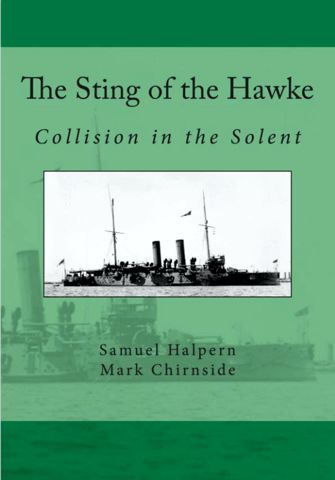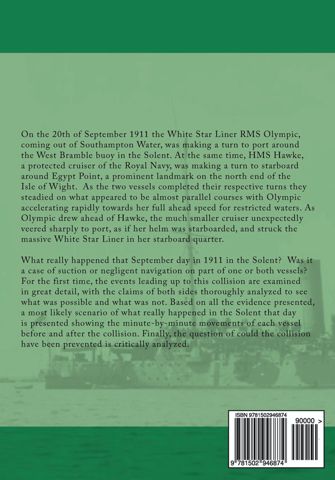|
On the 20th of September 1911 the White Star Liner RMS Olympic, coming out of Southampton Water, was making a turn to port around the West Bramble buoy in the Solent.
At the same time, HMS Hawke, a protected cruiser of the Royal Navy, was making a turn to starboard around Egypt Point, a prominent landmark on the north end of the Isle of Wight.
As the two vessels completed their respective turns they steadied on what appeared to be almost parallel courses with Olympic accelerating rapidly towards her full ahead speed for restricted waters.
As Olympic drew ahead of Hawke, the much smaller cruiser unexpectedly veered sharply to port, as if her helm was starboarded, and struck the massive White Star Liner in her starboard quarter.
As a result of the collision, both vessels suffered severe damage and had to return to port for repairs.
As a result of the damages to Olympic, the maiden voyage of her sister ship Titanic was delayed from the 20th of March to the 10th of April while considerable labor, parts and materials were diverted to repair Olympic.
That delay in Titanicís schedule later proved to be fatal.
At the trial that followed the collision in the Solent, both sides blamed the other for the mishap.
Olympic claimed that Hawke was an overtaking vessel coming up from behind, and as such should have given way to Olympic.
Hawke claimed that Olympic was a crossing vessel, and having Hawke on her starboard side, was obligated to give way to Hawke.
During the one-sided Admiralty hearings held in Portsmouth only two days after the collision, it came out that Hawkeís helm had jammed at a critical moment just as an uncontrollable force seemed to pull Hawke toward the much more massive ocean liner.
At the Court trial that followed in November, the Admiralty claimed that Olympic made too wide a turn around the buoy bringing her too close to the port side of the cruiser, and the suction created by Olympicís close proximity and excessive speed caused the cruiser to swerve uncontrollably to port thereby bringing about the collision.
What really happened that September day in 1911 in the Solent?
Was it a simple case of hydrodynamic suction or negligent navigation on part of one or both vessels?
For the first time, the events leading up to this collision are examined in great detail, with the claims of both sides thoroughly analyzed to see what was possible and what was not.
Based on all the evidence presented, a most likely scenario of what really happened in the Solent that day is presented showing the minute-by-minute movements of each vessel before and after the collision.
Finally, the question of could the collision have been prevented is critically analyzed.
|





